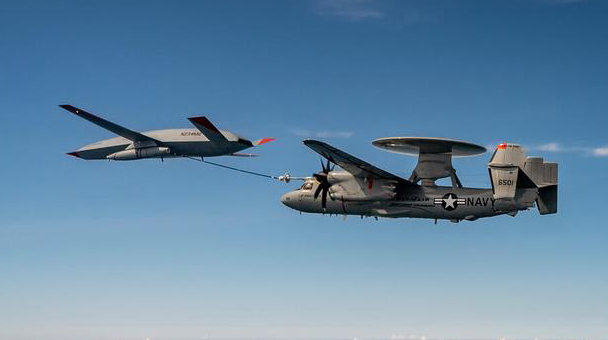The new MQ-25 carrier-based unmanned tanker completed its first aerial refueling flight with an E-2D aircraft.
The MQ-25 Stingray achieved another first on Aug. 18, 2021, by conducting the first air-to-air refueling with an E-2D aircraft at MidAmerica Airport in Mascoutah, Illinois.
The Boeing-owned MQ-25 test asset, known as T1, transferred fuel to an E-2D Advanced Hawkeye, the most recent variant of the Hawkeye platform, that was given an AAR (Air-to-Air Refueling) capability in 2019, in a test that follows the very first aerial refueling between an unmanned tanker and a manned receiver aircraft that took place on June 4, 2021, with the Boeing-owned MQ-25 T1 test asset flying from MidAmerica Airport in Mascoutah (Illinois) and employing the Cobham Aerial Refueling Store (ARS), and a U.S. Navy F/A-18F Super Hornet.
“Once operational, the MQ-25 will refuel every receiver-capable platform including E-2,” said Capt. Chad Reed, the Navy’s Unmanned Carrier Aviation (PMA-268) program manager in a NAVAIR (Naval Air Systems Command) release. “This flight keeps us on a fast track to getting the Stingray out to the fleet where its refueling capability will greatly increase the range and operational flexibility of the carrier air wing and strike group.”
According to NAVAIR, the test flight lasted 6 hours. Navy E-2D pilots from Air Test and Evaluation Squadron Two Zero (VX) 20 approached T1, performed formation evaluations, wake surveys, drogue tracking and plugs with the MQ-25 test asset at 220 knots calibrated airspeed (KCAS) and 10,000 feet with the purpose of analyzing the aerodynamic interaction of the two aircraft. The outcome of the test will be used to determine if any adjustments to guidance and control are required and make those available via software updates.
The MQ-25 and the IFR (In Flight Refueling) probe of the E-2D are going to boost the capabilities of the Advanced Hawkeye that will become an asset able to perform Airborne Early Warning and Comprehensive Battlefield Management for extended periods of time.
Another #MQ25 refueling in the books. The T1 test asset just refueled a @USNavy E-2D Hawkeye command-and-control aircraft. This is the unmanned aerial refueler’s second refueling mission. pic.twitter.com/53R8HdcvFB
— Boeing Defense (@BoeingDefense) August 19, 2021
As we already reported, the MQ-25 T1 is the predecessor to the four engineering development model (EDM) MQ-25 aircraft being produced, the first of which is expected to be delivered later this year. The MQ-25 will be the world’s first operational carrier-based unmanned aircraft and provide critical aerial refueling and intelligence, surveillance and reconnaissance capabilities. The U.S. Navy is planning to procure more than 70 aircraft, which will replace the F/A-18E Super Hornets in the aerial refueling role they currently have as part of the Carrier Air Wing, becoming also the first operational carrier-based UAV. This way, the Carrier Air Wing will have more Super Hornets available for operational mission, without the need to reserve some of them for the air-to-air refueling mission.
More testing will be conducted over the next months, to include flight envelope expansion, engine testing, and deck handling demonstrations aboard an aircraft carrier before the EDM MQ-25 aircraft are delivered in 2022. Later this year, the U.S. Navy will stand up Unmanned Carrier-Launched Multi Role Squadron (VUQ) 10, the fleet replacement squadron; then, two MQ-25A squadrons, VUQ-11 and 12, will be established. These squadrons are set to deploy aboard U.S. Navy’s aircraft carriers.
“MQ-25 is leading the way as naval aviation transforms to include cutting-edge unmanned platforms,” said Capt. Michael France, the Navy’s Airborne Command & Control and Logistics Wing (ACCLW) commodore. “Our fleet integration team (FIT) is actively preparing for the Stingray’s arrival and we’re excited for the innovative capabilities of the MQ-25 that will transform our mobility and power projection. For the first time, the eyes and ears of the fleet will now be able to provide up-to-the-minute information from deep within theater to facilitate rapid-decision making by carrier strike group leadership.”









